
From the epidemiological history of Aden The Plague Epidemic [Archives:2001/52/Health]
December 24 2001
Dr. Walid Nasser Abdulla Kaid*
Plague or Black Death is considered as one of the serious diseases that emerge from time to time in the form of separated cases here and there in different places in the world or as an epidemic as it used to take place in the past.
Plague is one of the Zoonotic diseases that are communicated from animals to man. The cause of the disease is a kind of organisms called Yerssinial Pestis.
The plague germs are communicated form rats and other rodents to man through a kind of fleas. The fatal rodents are of great importance during the period of the diseases spread out as they play an essential role in communicating the disease form rodent to man.
Plague outbreak in Aden:
On the ninth of January 1928, the health department in Aden protectorate announced the outbreak of plague cases (bubonic form) in isolated area of the town of Al-Tawahi where coal coolies working with the companies which supply the steamers anchoring in the port of Aden lived.
The health department in the colony of Aden was optimistic, it emphasized that the epidemic was under control. All plague patients were admitted to the hospital of infectious diseases in Mualla at the time, the contacts cases were moved to flint island by boats (presently called the Laborers Island) for observation and quarantine. They were provided with Shelter, cloths, food and water.
Immediate prophylactic measures were carried out in the focus area of infection including; mice killing to poisoning, burning of cloths, disinfection of the Quarter which seemed to be lack of environment sanitation.
The port health office took strict preventive measures for the crews of all ships staying in the port of Aden in order to maintain the economical activities of the port and its global reputation.
Despite the health procedures that had been taken, the horrible image of the epidemic worsened as the number of infected persons increased and the disease moved from the area of infection to other regions such as Crater Aden, Mualla and later to the town of Sheikh Othman and kept harvesting peoples lives for about five months.
The official figures showed the total number of deaths reached 1107 cases, whereas it was estimated that the actual number of death could exceed that.
Table (A) shows that the highest frequency of infected cases of plague (785) took place in March; this reflects the weal preventive measures in the two proceeding months.
It is worthwhile to note that the gradual decrease in the number of cases in April is due to the beginning of summer season when the weather temperature rises and this is necessary to kill the fleas and thus the chain of infection breaks.
If the mice were destroyed while the fleas left alive, then this is considered as an actual catastrophe because the fleas which carry the disease would be deprived of their primary host i.e. the mice and as they will directly go to man and so the disaster will be more destructive.
The table shows that the case-fatality ratio during the epidemic period rose from 42% in January to 94% in May, and this indicates the deterioration of therapeutic measures of the cases either because of drug shortages and poor emergency medical care, or the late arrival of plague patients to the hospital due to the absence of heath awareness among the local population in Aden.
It is necessary to point out here that the drugs such as Tetracycline and streptomycin which are prescribed for plague cases were not available at that time, for instance streptomycin was discovered only in 1950.

On the second of June, eight days after the last reported case of plague, the health department in Aden protectorate announced that the epidemic of plague in Aden was eradicated and the city was free of the disease. The health restrictive measures were lifted and so were the quarantine and the preventive health procedures in the port.
Aden was comforted and trouble was finished after one third of its population lived in panic. One may imagine the volume of psychological, social and economic devastation imposed by the epidemic on peoples life then.
Generations succeeded one another and the epidemic entered the tunnel of forgetfulness, but the remains of the plague victims cemetery stones at Sheikh Othman city will remain as a silent witness to the most disastrous epidemic Aden was exposed to in the last century.
__________
* Dr. Walid Nasser Abdullah Kaid is a Community Medicine Specialist (M.B.Ch.B., FIMCS/CM) at the Community Medicine Department of the University of Adens Faculty of Medicine
——
[archive-e:52-v:2001-y:2001-d:2001-12-24-p:./2001/iss52/health.htm]


